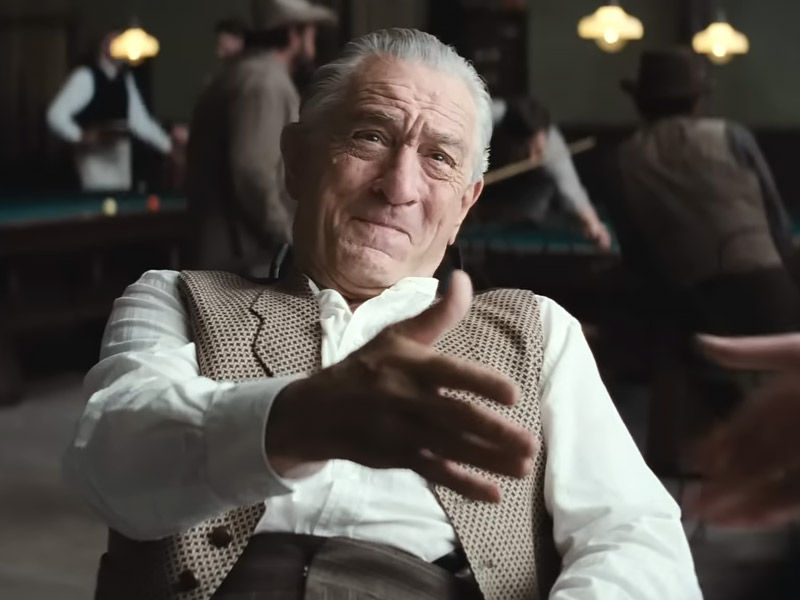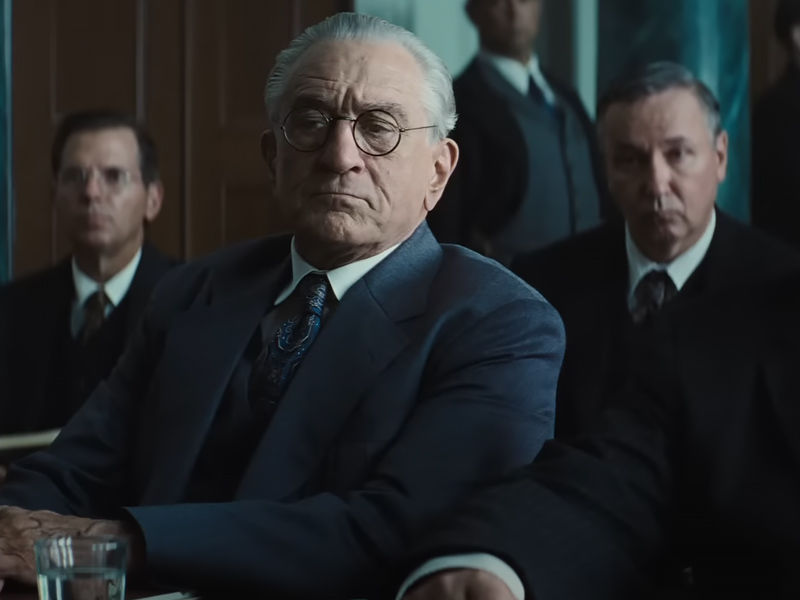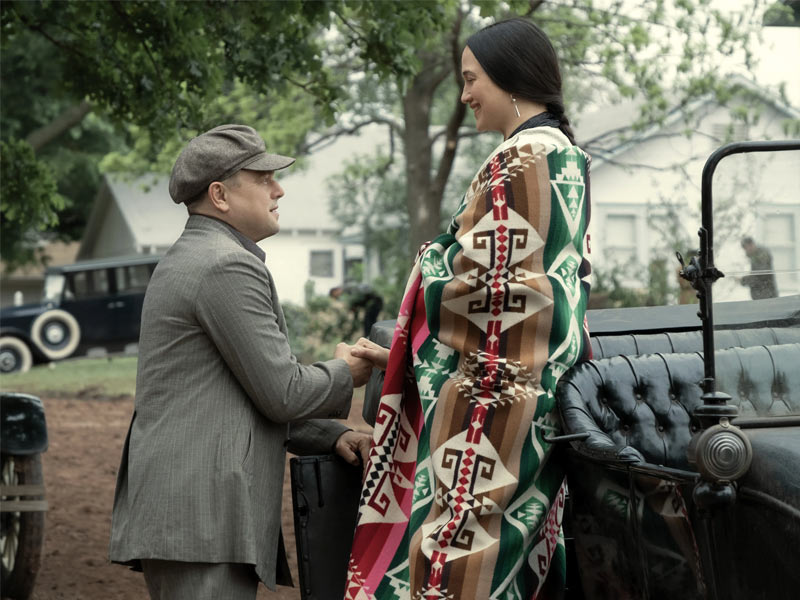Few tales concerning the annihilation of the Native Americans in America give the tale credit. Many people draw attention to the violence and misery of the victims, turning it into entertainment. Some people would rather concentrate on the white characters while giving the Native Americans minor roles.

Killers of the Flower Moon, in certain ways, steers clear of many of these cliches. Martin Scorsese, the film’s director, takes pains to present the story from a variety of angles, including that of Mollie, played by Lily Gladstone and an Osage native.
A Series of Ghastly Murders in 1920s Oklahoma Are looked at in “Killers of the Flower Moon”
The heartbreaking actual account of the murder of Osage people by individuals determined to gain their riches and property is depicted in the David Grann nonfiction novel Killers. The main character of the movie is Leonardo DiCaprio’s Ernest Burkhart, who recently got back from World War I to his uncle’s ranch in Oklahoma.
In the town of Fairfax, his uncle William “Bill” Hale (Robert De Niro) essentially commands everyone to refer to him as “King.” He has a lot of influence and first appears to be an ally of the Osage people.

He appears to respect them, speaks their language, and frequently expresses his friendliness with them.
But a vicious, avaricious, and power-hungry guy lies beneath that humorous and kind exterior. Ernest and the viewer quickly understand Bill’s role in the spate of killings affecting the neighborhood.
The Osage nation became home to some of the wealthiest people in the nation after hitting it big with the oil on their territory. The Osage became wealthy as a result of their ability to hang onto their land, making them prey for individuals like Bill.
White males frequently wed Osage women so they may readily inherit them once their wives pass away. There are no inquiries or investigations.
Bill has his sights set on a sizable reward. Mollie Kyle is the daughter who will succeed in a sizable estate after her mother passes away. He persuades Ernest to become friends with Mollie, and the two quickly fall in love and get married.

Ernest, on the other hand, is a little naive. He loudly declares that he loves money, yet he frequently feels uncomfortable when his uncle forces him to carry out his orders.
It might be simple to claim that Ernest is a good person at his core. However, the movie raises the question of how much blood must be on your hands to be pardoned for your misdeeds and get forgiveness.
The Length of “Killers” Almost Justifies It
Killers of the Flower Moon clocks in at 206 minutes, just three minutes shorter than The Irishman, and it is well worth the time. Even though it is lengthy, sharing a story of this scope is vital. When the film brings additional players to the game in the shape of Federal agents in the third act, the pacing alters, slowing down and frequently feeling lethargic.
Here is where I have some doubts about Killers, which mainly come from the source material. The FBI and J. Edgar Hoover, a guy who history has revealed to be divisive, are both glorified in David Grann’s original book.

Yes, the federal government looked into these killings, but only after more than a dozen people had died, after receiving a sizable payment from the Osage nation, and after compelling the Osage leaders to fly to Washington, D.C. If there is a hero in the movie, it is Tom White from the federal government, played by Jesse Plemons.
It seems pretty one-dimensional to have government officials swooping in like heroes in a movie that opens with a vignette of a wild and illegal region full of bloodshed, corruption, and greed. After all, Native Americans are only confined to Indian reservations as a result of that government.

The same people who stole their country, colonized their people, and destroyed their culture also created these regimes. Most residents of the community are upfront about their hostility toward Native Americans. Men publicly pursue Native women who, a few years later, mysteriously pass away, driven by their own white wrath and sense of manifest destiny.
Scorsese isn’t afraid to demonstrate how viciously and easily these people dehumanize Native Americans.
Is Martin Scorsese the Best Director for This Kind of Story?
But I can’t help but ponder. Is Martin Scorsese the right choice to direct this tale of a failed nuclear holocaust? The film, like many others before it, centers on a white lead character. Without question, Ernest serves as our protagonist, while Bill serves as his antagonist.
No matter how torn or loving he may seem, it’s impossible to empathize with someone willing to kill those closest to his wife to gain money. Ernest’s guilt is what we are dealing with. Like so many other Native American figures, Mollie is portrayed as a woman who must endure constant suffering.

I have to wonder how a Native American director would have handled the writing and directing of this drama. Definitely, not as much of the duration would have been devoted to Ernest and Bill. Beyond Mollie, the other Indigenous characters lack unique identities or genuine growth. After watching the entire 206 minutes, one thing about Killers stands out as disappointing.
DiCaprio, De Niro, and Gladstone all provide strong performances.
Killers are without a doubt a success for its leading cast, even though I have some concerns about some of Scorsese’s choices. DiCaprio portrays Ernest as fully flawed as possible. DiCaprio is not an unreliable, annoying character, by any means. He makes someone who ought to be hated into someone who is nearly sympathetic.
On the other hand, De Niro’s portrayal of Bill as an avaricious and cunning monster is just right. To appear unthreatening, he freely integrates himself into the Osage culture and establishes himself as a respected member of society. He has a reputation for saying things like, “I’m not racist, I have so many Osage friends!” De Niro portrays him with all the appropriate delectable menace.

However, Gladstone’s portrayal of Mollie takes the prize hands down. Gladstone makes the most of her character as an unyielding, tenacious, and enigmatic woman, showing all the sorrow and fortitude necessary for a woman who is nearly always in mourning.
Brendan Fraser and John Lithgow, among others, make only brief appearances as flat, one-dimensional characters in other performances. Nevertheless, Lithgow and Fraser both possess the strength and presence necessary to take control of a scene in any circumstance.
Also, Read 9 Best Historical Dramas on Netflix
Fans of Scorsese should watch “Killers of the Flower Moon,” but it doesn’t tell a full story.
Killers of the Flower Moon ultimately fail to make an impact. It is neither a movie that will change your life nor is it Scorsese’s finest work. But it is a committed examination of a terrible period in history and does its best to tell a fair tale.
To Scorsese’s credit, he does not downplay the story’s unfairness. He is correct to point out that even in the end, marginalized groups of people do not always receive justice.

For those who can get past its romanticism, Killers of the Flower Moon is worth watching because of its excellent cast, gorgeous color scheme, and setting.
If you’re hoping for a movie with a more in-depth plot or one with prominent Native American voices and characters, keep looking; even at three and a half hours, this isn’t it.





























